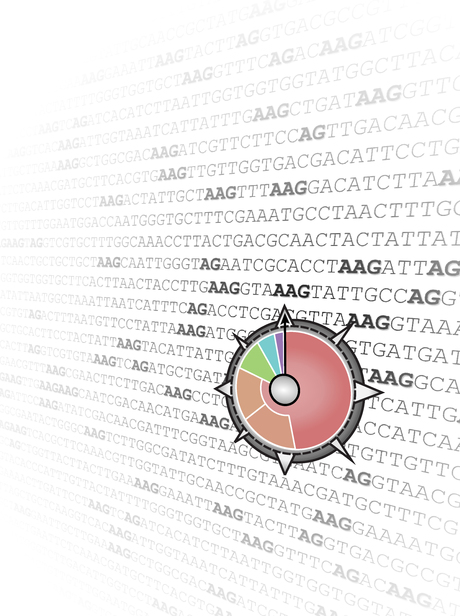Rapid identification of CRISPR-Cas system PAMs

CRISPR-Cas systems are the latest generation of genetic tools, but these tools require researchers to identify the protospacer-adjacent motifs (PAMs) that unlock each system’s functionality. Scientists from North Carolina State University have developed a set of techniques to identify these PAMs, with the results published in the journal Molecular Cell.
CRISPR-Cas systems protect bacteria from invaders, such as viruses, by creating small strands of RNA that match DNA sequences specific to a given invader. When those CRISPR RNAs find a match, they unleash proteins that chop up the invader’s DNA, preventing it from replicating. But the first step in the process isn’t comparing the RNA to target DNA — it’s PAM recognition and binding.
PAMs are short genetic sequences adjacent to the target DNA in viruses or other invaders. When the protein in a CRISPR-Cas system identifies a PAM, that identification tells the protein to bind to that DNA and begin comparing the adjacent DNA sequence to the CRISPR RNA. If the DNA and RNA match, the protein cleaves the target DNA.
“For researchers to make use of a CRISPR-Cas system for gene editing, gene regulation or other techniques, you first need to identify the relevant PAM sequences that trigger that specific CRISPR-protein combination,” explained Chase Beisel, a senior author on the NC State paper.
“For example, the CRISPR-Cas9 tool derived from Streptococcus pyogenes has a different PAM than the CRISPR-Cas9 tool derived from Staphylococcus aureus,” Beisel said. “There are thousands of potential CRISPR tools out there; to make use of them, we need an efficient way to identify their PAMs. And we think we’ve developed tools to do that.”
It is difficult to predict which genetic sequences function as PAMs for a given CRISPR-Cas system. And the genetic sequences that function as PAMs vary widely, even between closely related CRISPR-Cas systems. For example, the PAM that triggers the Cas9 protein from S. pyogenes consists of only three nucleotides, but the PAM that triggers the Cas9 protein from S. aureus contains six nucleotides — none of which overlap with those from S. pyogenes.
“To address this challenge, we developed a tool called PAM-SCANR,” said Ryan Leenay, lead author on the paper. “PAM-SCANR allows us to identify PAM sequences for any given CRISPR-protein combination.”
First, researchers start with a CRISPR-Cas system they want to find the PAM for. The relevant CRISPR-protein pair is then used as the reactive agent in a high-throughput screen that exposes the CRISPR-protein pair to many different gene sequences simultaneously. The gene sequences are part of a genetic construct engineered to light up when the CRISPR-protein pair binds to them. This can only happen if a functional PAM is present.
“One thing that makes this tool unique is that it could be used to screen and identify PAMs across a wide range of CRISPR-Cas systems,” Leenay said.
The researchers tested PAM-SCANR in five CRISPR-Cas systems across three of the four CRISPR types that are known to rely on PAMs to function. They also developed a tool called a PAM wheel that helps researchers visualise the output of PAM-SCANR screens and additionally allows them to see if some PAMs are better than others and by how much.
In testing PAM-SCANR, the researchers found that there can be multiple PAMs for a given CRISPR-Cas system — which was a surprise — and that some PAMs trigger a much stronger response than others.
“When we first discovered PAMs nearly a decade ago, we initially thought that only one PAM worked,” said Rodolphe Barrangou, a senior author on the paper. “However, our tools revealed there can be multiple PAMs for a single CRISPR-Cas system, and some PAMs clearly performed better than others as part of CRISPR recognising its target DNA.”
The researchers are already using PAM-SCANR to identify PAMs for CRISPR-Cas systems that may be the next generation of CRISPR tools. They’re also working to determine how different PAMs for a specific CRISPR-Cas system may affect that system’s effectiveness in any given application.
“For example, we want to know if the variability among PAMs has implications for genome editing and our ability to predict off-target sites — places a CRISPR-Cas system might attack other than the target DNA,” Beisel said.
Biomarkers for SIDS found in blood samples
US researchers have revealed the fingerprints of sudden infant death syndrome (SIDS) within blood...
Uncurling and 'gluing down' DNA molecules for sharper imaging
Researchers at Nagoya University have demonstrated techniques for stretching and immobilising DNA...
Novel 3D bioprinter can replicate human tissue
Biomedical engineers have invented a 3D printing system capable of fabricating structures that...




